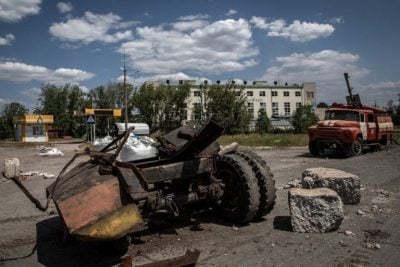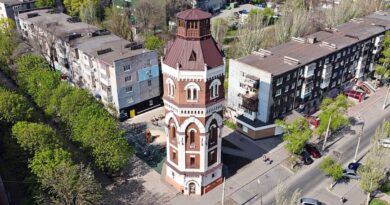Ukraine After 90 Days of War

To receive Global Research’s Daily Newsletter (selected articles), click here.
Visit and follow us on Instagram, Twitter and Facebook. Feel free to repost and share widely Global Research articles.
***
The Western narrative that Russia is facing defeat at the hands of the Ukrainian military is falling apart. The contrived narrative that Ukraine was “winning” made Kiev delusional which in turn created conditions for Washington and London to extend the war and incrementally enter into it laterally and turn it into a war of attrition against Russia.
But the compelling reality is that the Russian forces are steadily seizing the upper hand in the Battle for Donbass. The Ukrainian Defence Ministry spokesperson said on Tuesday that “the most active phase” of the Russian special operation has begun in Donbass. In military terms, Russian forces face the daunting task of taking over the best-fortified areas of Ukraine, which have been carefully preparing for this battle for seven years. But on the other hand, after their triumphant victory in Mariupol, Russian forces have the wind on their sail.
Looking back through the past 3-month period, Russia’s topmost priority has been to establish a land corridor to Crimea and put in place the economic underpinnings for the region’s development. That objective stands fulfilled. It is from such a viewpoint that the current operation in Donbass needs to be understood. Ukraine and its Western allies are pinning hopes that the sanctions will eventually exhaust Russia’s military and economic potential.
But life is real. By the World Bank estimates, Ukraine’s economy may shrink by 45 percent by the end of 2022. The talk of a major Ukrainian counter-offensive later this year bolstered by the heavy weaponry from Western allies, will remain a pipe dream. Kiev may not even have sufficient manpower to wage a war by the end of the year. Russia is a formidable enemy and Kiev may be risking an abject surrender on humiliating terms in the downstream of the Battle for Donbass.
The Russian forces are now close to establishing full control of the Luhansk region of Donbass. The Ukrainian governor of the eastern region admitted on Tuesday that “The Russians are advancing in all directions at the same time; they brought over an insane number of fighters and equipment.” The situation is looking increasingly precarious for the Ukrainian forces. (Listen to the podcast The Battlefields of the Donbass and Beyond, War on the Rocks)
The key signposts are Popasnaya and Severodonetsk in Donbass and the city of Izyum just to the north in the Kharkiv region. Popasnaya and Izyum are under Russian control already while Russian troops entered Severodonetsk yesterday.
The Russian forces are currently expanding their control zone around Popasnaya to its north, west and south; they have approached the outskirts of the city of Severodonetsk; and have resumed their advance to the west and south of Izyum.
Latest reports are that assault groups from Popasnaya are heading west towards Bakhmut, which is a strategic hub for Kiev to replenish its forces in the eastern region. The highway between Bakhmut and Lisichansk is within firing range of Russian forces and military supplies to the Ukrainian grouping in Severodonetsk and Lisichansk have become problematic.
As for Izyum, in the area of Liman to its south (west of Severodonetsk), Russian forces have surrounded the Ukrainian forces. The Russian forces entered Severodonetsk city yesterday and there is street fighting going on.
Severodonetsk is a highly strategic asset for both sides. An estimated 15-16 thousand Ukrainian servicemen are deployed there, who are being reinforced. If Russian forces succeed in trapping and destroying the Ukrainian forces between Severodonetsk and Lysychansk, Kiev’s ability to contest the eastern Donbas region will be seriously weakened.
On Monday, Russian forces succeeded in destroying all but one bridge into Severodonetsk, threatening to cut the city off from supplies and reinforcements. A retreat and regrouping by the Ukrainian forces seems too late. The big picture is rather grim. The National Interest magazine assessed the developing situation as follows:
“The coming battle could prove decisive to the course of the Kremlin’s Donbass campaign. Russian control over the eastern Donbas region would cut Ukraine off from the areas comprising its industrial heartland and fulfil the Kremlin’s key strategic goal of establishing a secure land bridge to Crimea.
“If Russia’s military successfully traps and destroys the Ukrainian forces between Severodonetsk and Lysychansk, they will significantly degrade Ukraine’s ability to contest the eastern Donbas region. It is unclear if Ukrainian military units in the Severodonetsk salient are considering plans to retreat further westward in order to avoid potential Russian envelopment.”
The next big target in the Russian sights is Slovyansk. Controlling it would enable Russian forces to drive west and link up with the forces pushing south-east of Izyum. The objective is to control the supply lines by road and block Ukrainian access to rail routes from the west. Ten Ukrainian brigades were deployed in the east when the war began in February, which were regarded as the best-equipped and best-trained soldiers that Kiev has.
Indeed, the fall of Mariupol to the Russian military represents a turning point. Russia now has a land corridor to Crimea and has ended Crimea’s water and power blockade. The freshwater canal connecting the Dnieper River to the arid Crimean Peninsula is now in Russia’s hands. So is a nuclear power station to the north of the peninsula, not to mention the power grid in southeastern Ukraine which can be now connected to Russia. These are strategic gains for Russia.
Beyond Donbass and Crimea, Russia might have other objectives too in the southern region. There have been demands — at the local level so far — for merger of the southern regions of Zaporizhzhia, Kherson and Mykolaiv with Crimea (Russia), which have large Russian population. Some degree of integration of this region with Russia seems to have begun.
In Kherson region, Russian currency ruble has been introduced; Russian, along with Ukrainian, will become a state language and will become the main language for office work, communication and all issues of national importance; teaching in schools and universities will be conducted in Russian. The authorities of the Kherson Region have voiced the demand for establishment of a Russian military base in the region.
The secretary of Russia’s Security Council, Nikolai Patrushev, said in an interview published Tuesday that the Russian government “is not chasing deadlines.” Indeed, the Western estimations also seem to anticipate future Russian operations in the southern regions. There are pointers. On May 23, the US Defense Secretary Lloyd Austin announced that Denmark will provide Ukraine with a modern Harpoon anti-ship launcher and missiles to safeguard its coasts. On May 24, Hungary announced national emergency to take immediate steps to be able to project the country against threats emanating from the war in Ukraine. Over the last weekend, Moscow publicly voiced disquiet over a British statement about the possibility of NATO arms supplies to Moldavia.
*
Note to readers: Please click the share buttons above or below. Follow us on Instagram, Twitter and Facebook. Feel free to repost and share widely Global Research articles.
Featured image is from Indian Punchline
This article has been archived for your research. The original version from Global Research can be found here.


